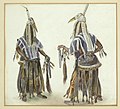Ethnographic image archive of the Frobenius Institute
The ethnographic image archive of the Frobenius Institute in Frankfurt is a global documentation on material culture, art and architecture, ritual life and the economy. The total stock currently comprises almost 30,000 historical illustrations from five continents, with the regional focus on Africa dominating. Most of the material was made by specially committed draftsmen during the numerous expeditions of the Frobenius Institute from 1904 to 1965. The oldest parts of the collection date from the first half of the 19th century.
Focus of the collection
The focus of the specialized picture collection is on material culture, art and architecture, ritual life and economy. The unique collection is the result of an institutional collection and documentation activity that began in 1898 and continued in 1938 after the death of the institute's founder, Leo Frobenius . One of the special features of the research expeditions led by Frobenius is the great emphasis placed on visual forms of documentation. Accompanied by a team of ethnographers, draftsmen and photographers and guided by the notion that the ancient culture of Africa is inevitably doomed, he tried to document ancient Africa as comprehensively and systematically as possible. Some well-known artists such as Carl Arriens , Hans Martin Lemme , Alf Bayrle or Albert Hahn created a collection of pictorial documents that is unique in Europe. The holdings were supplemented by donations and purchases of other collections. The earliest pictorial documents date from the first half of the 19th century.
Collection holdings
The ethnographic image archive consists of the following sub-stocks:
- The actual picture collection with over 8,700 original drawings, ink and pencil sketches, watercolors, gouaches, oil paintings and photographs of different formats (18x25, 25x35, 30x40, 48x65, 70x95 cm). The images relate primarily to Africa, Oceania and Australia. This collection also includes historical illustrations by indigenous artists from the respective research regions.
- The picture index: almost 20,000 images of a small-format picture index divided into 96 subject areas (from architecture to throwing iron ). For the most part, these are artistically high-quality original drawings (especially ink, pencil, red chalk) of material culture, art, architecture and body decoration, which comprehensively document regional specifics such as local-historical changes.
- Six smaller, important special collections, including original drawings from the mid-19th century by Georg Schweinfurth and Hyacinthe Hecquard (1814–1866), who traveled to Africa, and the painter Johann Martin Bernatz .
Relevance of the collection
The institute's ethnographic picture collection has always been the subject of lively scientific and artistic interest. In contrast to Frobenius's time, who created the picture collection to confirm his (already controversial) cultural morphological theories, the picture material is now valuable for a visual ethnology that locates each picture document in its historical and cultural context and places it together with the available written sources and - supplemented by a critical questioning of the context of development - seeks to analyze it in its overall context.
There were exhibitions of the image material in 2008 in the Musée National in Ouagadougou, Burkina Faso and from 2010 to 2011 in Abuja and five other Nigerian cities.
In the years 2006–2009 the holdings were reworked as part of the DFG project Digitization and Indexing of the Ethnographic Picture Collection of the Frobenius Institute .
literature
- The Frobenius Institute at the Johann Wolfgang Goethe University. 1898-1998 . Foreword: Karl-Heinz Kohl . Frankfurt am Main, Frobenius Institute, 1998
See also
Web links
Individual evidence
- ^ Ethnographic Image Archive - Frobenius Institute Frankfurt am Main. (No longer available online.) Archived from the original on October 22, 2016 ; accessed on May 29, 2017 (German). Info: The archive link was inserted automatically and has not yet been checked. Please check the original and archive link according to the instructions and then remove this notice.





